Plico Virtual Power Plant 2023-24 Frequently Asked Questions
A Virtual Power Plant (VPP) is a network of distributed energy resources (DER), in our case household solar + battery and battery only systems, that is managed remotely to provide services to the grid.
VPPs can control the supply and demand of energy utilising their participants’ systems to help stabilise the grid. VPP participants can also contribute to supply and demand management by changing their behaviours.
Just as a network operator can stop the supply of energy from rooftop solar, Plico’s VPP can limit the amount of solar exports when supply in the grid exceeds demand. But the great thing is that Plico members can get paid for providing this service.
And on the flip side, Plico’s VPP can provide an additional source of energy to the grid when needed just like a coal-fired power station provides a supply of energy to meet demand - although in our case it is clean energy! The energy in Plico’s VPP is sourced from rooftops scattered across WA and stored in solar batteries. Think of it as a clean, green, pop-up power plant.
You will receive a bonus payment of up to $100 if you have a full Plico solar + battery system, or up to $50 if you have a Plico battery only system, installed before 1 April 2024, just for being part of the VPP and keeping your inverter online. You will also receive a credit on your Synergy bill or Plico account for the energy you use during activations and tests.
VPP Credits
Peak demand activation
You will be credited for the energy you purchase from the grid while your battery is charging/storing and energy exported from your battery for all peak demand VPP tests and activations. These credits will be applied to your Plico account in April 2024 when our peak demand service concludes.
You will also continue to receive DEBS payments for your solar exports, and these will appear as they currently do on your Synergy bill.
Minimum demand activation
You will be credited for any energy you purchase from the grid during a minimum demand activation; between 10:00 am and 2:00 pm. This will be included in a future Synergy bill from 2024 as ‘Plico Synergy VPP Credit’.
Energy you use during a minimum demand test or activation is paid back as a credit. You can make the most of this by offsetting energy you would use later in the day and by using it during the activation period, 10:00am to 2:00pm, instead.
The amount you are credited will match whichever Synergy tariff you are currently on. For most Plico members this is the Synergy Home Plan A1 Tariff. For up-to-date pricing please visit: https://www.synergy.net.au/Your-home/Energy-plans/Home-Plan-A1 You will be credited at this rate for the energy you use during the test unless you are on a different Synergy tariff.
VPP Bonus
Members with systems installed before 1 April 2024 will receive a bonus payment for being part of the VPP. This will be provided as a credit on your Plico account. Your weekly fee will be reduced up to the value of the bonus payment you are eligible to receive. For systems installed by 31 December 2023, the VPP Bonus will be provided in January 2024. For systems installed between 1 January and 31 March 2024, the VPP Bonus will be applied in April 2024.
Plico VPP Bonus eligibility
|
System |
System installed as of: |
|
|
2023 |
2024* |
|
|
Plico solar + battery or solar only system |
$100 |
$50 |
|
Plico battery only system |
$50 |
$25 |
|
VPP Bonus applied to Plico account |
January 2024 |
April 2024 |
* Up to 31 March 2024
The bonus payment covers all Plico VPP activity over the next 12 months, from 1 October 2023 to 30 September 2024.
Note that all VPP financial rewards are subject to you providing your NMI to us and your inverter being online.
Peak demand is when supply to the grid is low and demand from the grid is high.
Peak demand usually occurs on hot summer afternoons and evenings when solar exports to the grid start to drop and demand increases.
Maintaining a balance between supply and demand is important for a stable and reliable grid. When energy demand is too high and supply is too low, it creates an imbalance that can lead to blackouts. Energy fluctuation is a challenge in maintaining a stable and reliable grid.
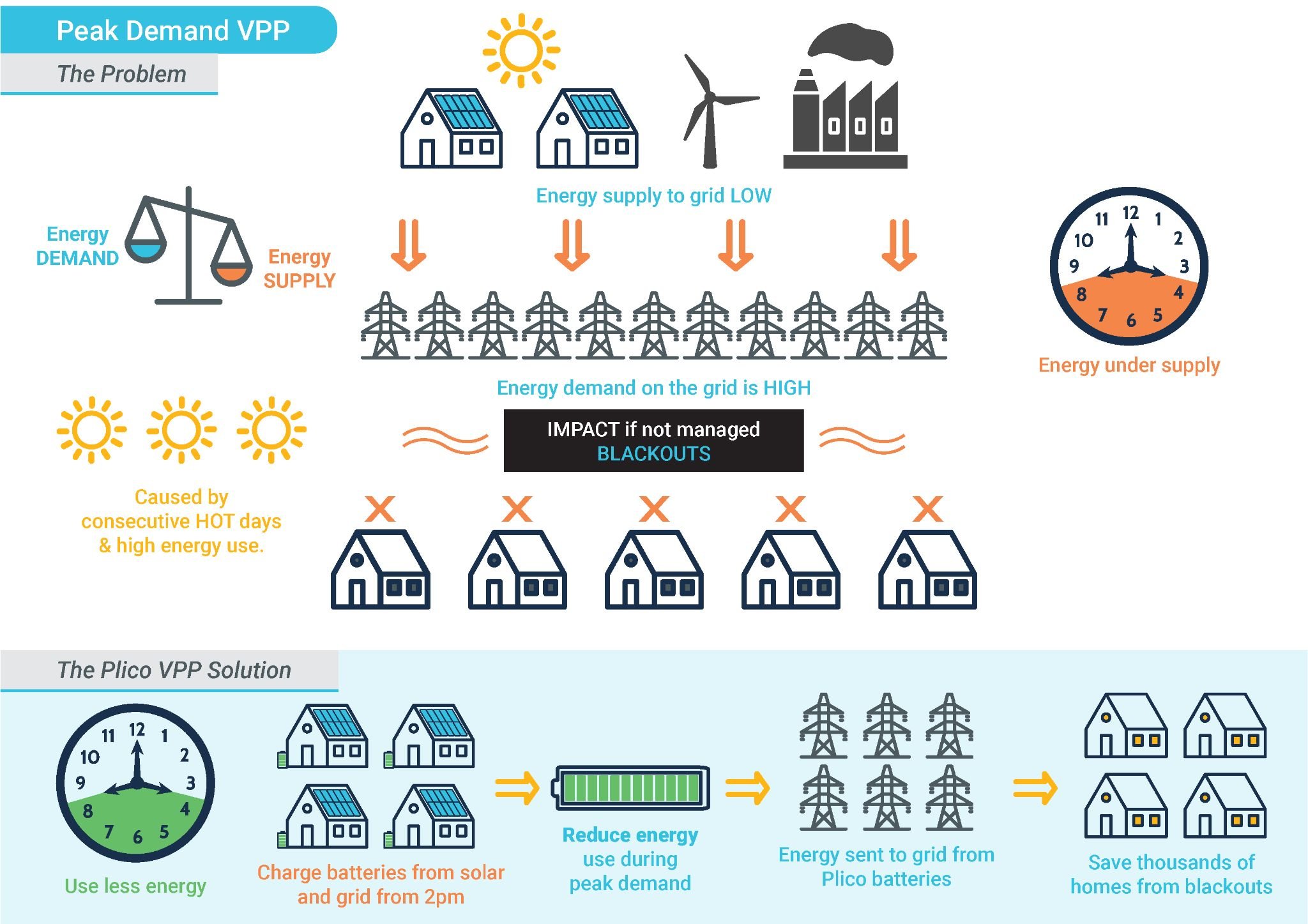
Your Plico battery will be controlled by the VPP during an activation.
On the day of a test or activation, the following things will occur:
- Your battery will be set to charge and store in preparation for the activation – it will not discharge to your home.
- Your battery will discharge directly to the grid for 2 hours between 3:30pm and 8:30pm. The less energy you use at this time, the more energy that can support the grid. Please reduce your energy use if you can and it’s safe to do so.
- Once the test has ended, your system will operate as normal.
You will be credited the costs of energy exported from your battery and any energy you purchase from the grid while your battery is charging/storing.
Please ensure your inverter is online.
You may consider reducing your energy use to increase your grid impact. A BBQ dinner, fish and chips on the beach or spending time at your local park will help maximise energy exports from your battery. You may also choose to switch your A/C, computers and TVs off and delay your washing, retic and pool pumps until after 9pm.
Note: Once an activation has been announced, you will not be able to utilise the energy stored in your battery until the activation window has ended.
In the event there is a blackout in your area at the same time as a VPP activation, your system will not discharge to the grid. It will power only your back-up circuit to maintain grid safety.
To find out if a peak demand activation is underway, please refer to the Member Support page on the Plico website.
Coal production is at an all-time low and most coal power stations will be phased out by 2030. As we move away from coal in the energy mix, the grid is challenged to provide enough dispatchable power for times of peak demand. During the day, solar exports provide additional energy to power our homes and businesses, however when this drops the grid is left with an undersupply of energy.
Hot summer afternoons create perfect conditions for peak demand to occur. While solar provides ample energy supply in the middle of the day, it begins to drop off when at the same time demand increases, as everyone gets home from school and work and begins to cool their home. These fluctuations pose a significant challenge to maintaining a stable and reliable grid.
Our VPP is designed to financially benefit Plico members through the VPP Bonus and VPP credits. You are always compensated for your energy.
Drawing from the grid overnight
During a peak demand activation, your battery storage helps boost energy supply to the grid. This usually means you need to draw energy from the grid overnight, to make up for the energy used during the activation. The additional energy you need to purchase from the grid, because your battery is empty, is the same amount of energy that would otherwise be drawn from your battery. We credit you for any energy exported from your battery during the activation at your current Synergy peak tariff rate.
As an example, if you have a 10 kWh battery and 9 kWh is exported to the grid during a peak demand activation, we will credit you for 9 kWh. If you need to purchase an additional 9 kWh later that night, you will have already been compensated for the 9 kWh exported from your battery. This 9 kWh could be broken into 9 kW used in one hour, 1 kW used per hour for 9 hours, 2 kW used per hour for 4.5 hours and so on. Any energy use above 9 kWh overnight is energy you would need to purchase anyway, regardless of whether you started the night with a full battery or not.
Solar exports
During a peak demand activation, you also receive DEBS payments for your exports to the grid. These are around 10c/kWh and are credited on your next Synergy bill. This is in addition to the credits we apply to your Plico account in April for your peak demand activations.
Where does my energy go?
Your household energy consumption will always be prioritised in an activation. That means you can utilise all your self-generated power for your home as you normally would. Any energy that you’re not using will be exported to the grid during the two-hour discharge window. That is why we suggest you can reduce your energy if you wish to, so that you can increase your net VPP impact (increase your exports back to the grid).
Blackouts
The VPP will only use the available capacity in your battery. If you are concerned about blackouts, you can request to have your minimum State of Charge increased so that you have more reserve in the event of a blackout. Just send your request to: Member Support | Help is always available | Plico Energy. Note that the VPP won’t ever cause a blackout to occur.
Getting more value from your battery
For some members, a peak demand VPP activation allows them to get more value out of their battery by ensuring its full capacity is utilised. For example, if you often have battery capacity left in summer when the sun rises, it is simply topped up to full capacity. During an activation, the VPP can utilise up to all your available battery capacity to support the grid. This allows you to get more value out of your battery as we compensate you for energy you would have otherwise not utilised in your home.
If there are consecutive peak demand activations, such as during a heat wave, your battery is charged as normal during the day - ready to run your home and support the grid all over again.
You can also maximise your VPP benefits by using more energy during the battery charge and store window. This is the time to pre-cool your home, run the dishwasher, put a load of washing on and cook dinner. We credit you for any grid energy you use during this time.
Minimum demand is when supply to the grid is high and demand from the grid is low.
Minimum demand usually occurs in the middle of day on mild sunny weekends or public holidays when solar exports to the grid are high and demand is low.
Maintaining a balance between supply and demand is important for a stable and reliable grid. When energy demand is too low and supply is too high, it creates an imbalance that can lead to blackouts. Energy fluctuation is a challenge in maintaining a stable and reliable grid.
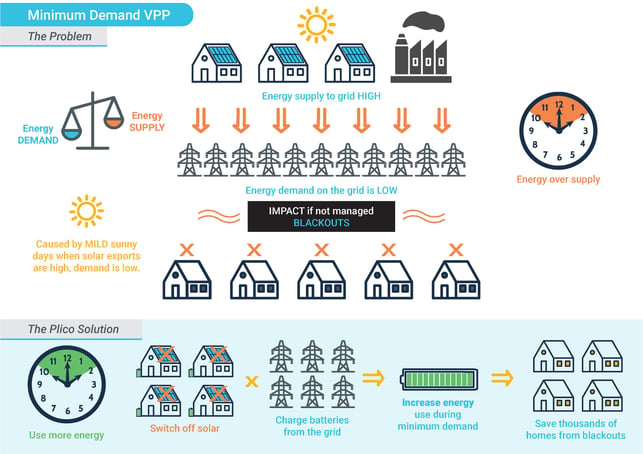
If you have a full Plico solar + battery system, your solar will be switched off. All of your household energy use will be drawn from the grid and your battery will charge from the grid.
If you added a Plico battery to your existing solar, you may choose to switch off your solar during the test. Contact us if you need assistance switching your solar off for the test.
On the day of a test or activation, the following things will occur:
1) At around 8:30 am, your battery will stop charging and we will notify you via SMS that your solar PV system will be switched off (full systems only) between 10:00 am to 2:00 pm.
2) At 10:00 am we will notify you via SMS that the activation has begun and that your solar pv system has been switched off (full systems only). You will draw all your household energy and charge your battery from the grid. We will ask you to increase your energy use at this time and ensure your inverter is online.
3) At 2:00 pm we will notify you via SMS that the activation has ended.
Your solar will be back up and running (full systems only). We expect Plico members will have a full battery and begin generating solar energy for their household needs once the test is complete.
If you have a battery-only system, you will be asked to switch your solar back on if you manually switched it off.
Once the test has ended, your system will operate as normal.
Please ensure your inverter is online and increase your energy use, if you can, during an activation, to ensure you provide maximum load on the grid. You can do this by setting timers on your appliances and using as many appliances as practical if you are home during an activation.
To find out if a minimum demand activation is underway, please also refer to the Member Support page on the Plico website.
Coal generators provide baseline power for the grid – when demand drops below this baseline it prevents these generators providing essential grid services.
When your home is not using the solar energy generated from your rooftop solar panels, the excess is exported to the grid. If that excess solar energy isn’t being used up because demand for energy is low, it creates an oversupply that destabilises the grid.
Mild sunny days create perfect conditions for minimum demand to occur; solar exports to the grid are high in the middle of the day, while household demand is low (homes and businesses are not using their A/Cs for cooling or heating). Then solar generation reduces in the evening and energy demand on the grid increases. These fluctuations pose a significant challenge to maintaining a stable and reliable grid.
While energy sources like wind, grid solar and gas can be switched off relatively easily to reduce supply to the grid and switched back on later in the day to increase supply, coal grid generators take up to 48 hours to ramp up.
Coal therefore cannot be managed in the same way to meet fluctuations in energy demand. When supply outstrips demand, or demand is greater than the supply, these grid generators cannot provide essential grid services like frequency control and voltage management.
In recent years, new records have been set for what is called minimum operational demand on the South West Interconnected Supply (SWIS), WA’s main grid network. The decrease in minimum operational demand has been largely driven by the rapid uptake of rooftop solar panels. AEMO publishes the minimum operational demand on its Wholesale Electricity Market (WEM) Data Dashboard.
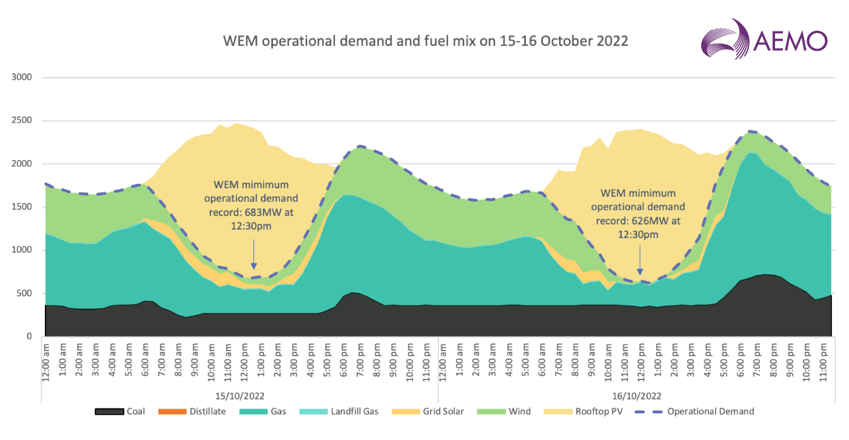
Because WA’s grid is isolated from other electricity markets, there is no option to send or receive excess energy from other networks.
Plico members are helping keep the grid in balance through the VPP.
The Australian Energy Market Operator (AEMO) has identified a potential shortfall of up to 326 MW for the 2023-24 Capacity Year in the SWIS (South West Integrated System – from Kalbarri to Bremer Bay and east to Kalgoorlie). This is almost double the shortfall identified in 2022-2023 when our VPP was activated on two occasions to support the grid manage peak demand. The shortfall is driven by several factors including: challenges with coal supply, potential reduction in reliability of ageing thermal generators and stronger than forecast demand growth.
The VPP also supports the grid manage minimum demand and the potential impact of solar oversupply in the grid network.
Plico members benefit financially for being part of our VPP and supporting the grid.
Our VPP can provide important grid services like minimum demand to help prevent blackouts and support the transition to clean energy. Our community is demonstrating how managed solar provides a real solution, and this benefits all users of the grid.
Plico members also benefit financially for being part of our VPP and supporting the grid.
Minimum demand occurs when energy supply to the grid is high and demand from the grid is low, and peak demand is when the oppositive occurs; supply is too low and demand is too high.
Both minimum demand and peak demand create a high degree of fluctuation between supply and demand at varying times, in a given day, and both scenarios can cause serious issues for maintaining grid stability.
The good news is that our VPP can help smooth out these fluctuations by managing supply and demand among our fleet of solar + battery and battery systems.
The table and diagrams below explain the key differences between minimum demand and peak demand, and what you can do to help.
|
VPP SCENARIO |
MINIMUM DEMAND |
PEAK DEMAND |
|
SCENARIO WINDOW |
10:00 am – 2:00 pm |
3:30 pm - 8:30 pm |
|
GRID ENERGY SUPPLY (Coal, gas, renewables. rooftop solar) |
Too high |
Too low |
|
DEMAND ON GRID ENERGY (Energy consumption by grid users) |
Too low |
Too high |
|
GRID BALANCE ACHIEVED BY |
Less supply, more demand |
More supply, less demand |
|
PLICO VPP RESPONSE |
Stop supply – switch off solar |
Increase supply – send stored energy to the grid |
|
PLICO MEMBER RESPONSE |
Use more energy |
Use less energy |

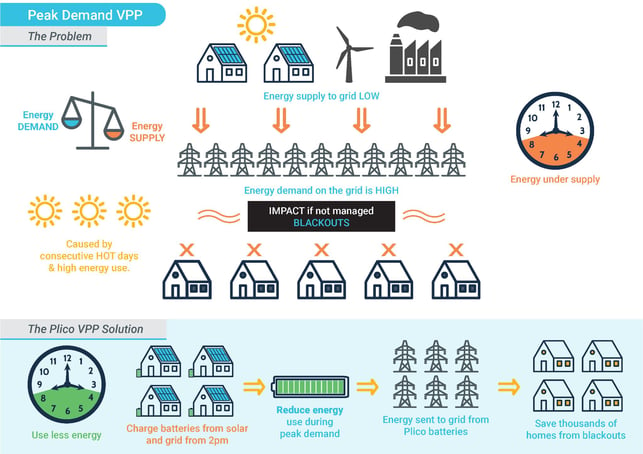
You will receive the VPP Bonus and credits for each eligible system you have.
That means if you have a full Plico solar + battery system at one property and a battery only system at another, you will receive a VPP Bonus of up to $150. Synergy bill and Plico account credits will be issued by the NMI.
No, you don’t need to take any action to be involved in the VPP.
We do, however need your NMI (National Meter Identifier). If we do not have your NMI on record, we will be in touch to get this information from you. You can find your NMI on your Synergy bill.
If you have a full Plico solar + battery or battery-only system installed and online, you will participate in the VPP. When you signed up with Plico, you also signed up to be involved in WA’s largest privately-owned VPP and receive the associated benefits.
Please check your inverter is online during all activations and VPP testing, as well as at all other times.
Your inverter needs to be always online so we can communicate with your system and include it in the VPP. If your inverter is offline, you will not receive credits for the energy you use during an activation or test and may be deemed ineligible for the VPP Bonus.
Peak demand activation
During a peak demand activation or test, you can reduce your energy consumption if you are home and it’s safe to do so. Reducing your energy use will ensure you get maximum benefits from your participation in the VPP and provide the most support to the grid to avoid blackouts. An activation will only be initiated during a grid emergency, therefore reducing your own energy consumption reduces demand on the grid and ensures that our VPP can provide additional capacity to meet this demand.
Read on for tips on how you can reduce your energy use during peak demand VPP activations.
Minimum demand activation
During a minimum demand activation or test, you can increase your energy consumption if you are home. This might feel strange to an energy smart Plico member, however it’s a very important part of helping the grid, avoiding blackouts and supporting the transition to clean energy. Increasing your energy use during an activation will ensure you provide maximum support to the grid. It’s also an opportunity to use as much free energy as you can, by shifting your energy use from later in the day to the activation window (10:00 am to 2:00pm).
Read on for tips on how you can increase your energy use during minimum demand VPP activations.
Increase your energy use by using as many electronic appliances in your home as practical during the activation window, from 10:00 am to 2:00 pm.
If you are home, then feel free to switch on plenty of appliances. Bit cold? Turn on the heating. Bit warm? Ramp up the A/C. Run the dishwasher and turn the TV on in the background. Cook yourself a hot lunch. Wash and dry your clothes – you could even freshen up your sheets and towels in the dryer. Put all your devices, tools and toys on charge so you don’t need to do it later. If you have an EV, charge it. Switch the pool filter on – anything and everything electronic you can think of!
We’re not recommending you be wasteful with your energy (or water) use - simply offset the energy you would use later.
Don’t forget to switch everything off at the end of the activation window at 2:00 pm, as you won’t be running on free energy from the grid anymore. However, once your panels start generating again and you’ll be using free energy from sun!
If you are away from home on the day of a VPP activation or test, you can use timers to help you manage your energy use.
Many dishwashers and washing machines now have inbuilt timers, or you can use manual timers on your power points. Any smart devices that can be controlled remotely can also be set on a timer.
You may also consider leaving your home during peak demand activations and staying home during minimum demand activations. Are your work arrangements and social plans flexible? The more people in your home during an activation, the more energy you will use and less people in your home, the less demand you’ll have on the grid. Depending on the type of activation, you have the power to make a big difference simply by switching your habits.
And don’t forget to return everything to normal after the activation, especially for a minimum demand activation. After 2:00 pm, you won’t receive credits for your energy. However, once your panels start generating again and you’ll be using free energy from sun!
The challenges posed by a declining minimum operational demand, which is driven in part by the rapid uptake of rooftop solar panels, led the WA Government to introduce Emergency Solar Management requirements in 2022.
This means that all new and upgraded solar PV and battery installations with an inverter capacity of 5kW or less must have the capability to be remotely turned down or switched off in emergency situations.
Understandably, this new requirement caused some angst among solar owners when it was introduced. The requirement was recommended by AEMO and provides a ‘last resort’ measure to manage emergency situations.
Our VPP can help avoid mandatory switching off of solar systems by reducing supply and increasing demand with our fleet of Plico solar + battery and battery systems. The best part is that Plico members would benefit financially because they are part of the VPP.
During a peak demand activation or test, your system will continue to export solar energy to the grid if your generation exceeds your household demand. You will continue to receive DEBS (or relevant solar exports scheme) payments for that period.
During a minimum demand activation or test, you will not export to the grid if you have a full Plico solar + battery or solar only system. This means that you will not receive DEBS (or relevant solar exports scheme) payments for that period. Your solar pv system will be switched off from 10:00 am to 2:00 pm and will not generate energy for your home or export to the grid. There will be a small loss in your solar feed-in tariff, or DEBS credit. This amounts to a maximum total of 50 cents per activation or test. If you are concerned about not receiving your solar export credits for the test period, we encourage you to shift your energy use into the activation window to cover this minor loss.
As a Plico member, you will always be no worse off under a VPP arrangement.
During a peak demand activation, your battery will be charged from the grid from around 3:30 pm.
During a minimum demand activation, your battery will stop charging at around 8:30 am and then begin to charge from the grid at 10:00 am.
In both cases, you will receive credits for the energy used to charge your battery.
Offline inverters cannot participate in the VPP.
It’s important to check the status of your inverter during a VPP activation or test. If your inverter is offline, we will lose communication with your system and therefore won’t be able to include it in the VPP. This means that you won’t be eligible to receive VPP financial rewards.
To find out if your inverter is online, simply check your Redback or Alpha ESS portal or app. If it is offline, you can get it back online with a few simple steps. If your inverter has a bypass switch, simply move it to the middle position for five seconds and then back to its original position (this should be DOWN for Redback systems and UP for Alpha ESS systems). Within a couple of minutes, your inverter should be back online and communicating with the VPP.
For more information on getting your inverter online visit Member Support.
All Plico members with an installed system are part of the VPP.
This includes Redback and Alpha ESS solar + battery and battery only systems. Inverters must be online for members to receive financial rewards from the VPP. New members who join while the VPP is mobilised for minimum demand will receive energy credits for activations and a portion of the VPP Bonus payment if installed by 31 March 2024. Members with systems installed after this date will be eligible for future VPP rewards.
All Plico members have signed a Virtual Power Plant Service Agreement contract. This means that when you joined Plico, you also joined the VPP.
Your agreement states that: we will supply a range of services to you or for your benefit, and we or our energy contractor may operate our equipment and provide VPP products to third parties through the wholesale electricity market or otherwise.
As part of your Plico contract, you have signed up to participate in the VPP. Please contact us to discuss a possible solution.
In the unlikely event there is a blackout during a VPP activation or test, switch to conserving energy in your home.
Activations and testing will not cause a blackout, however if one occurs at the same time your system will operate as it normally would during a blackout. Your battery will provide power to your back-up circuit and supply your home.
A reminder that if you have a bypass switch in your inverter, it needs to be engaged in blackout mode. This is the DOWN position for Redback systems and UP position for Alpha ESS systems.
You won’t receive a credit for the energy you use from your battery if there is a blackout during a VPP activation or test.
All Plico members with battery only systems will be part of the VPP in 2023-2024 to support the grid with both peak demand and minimum demand.
Minimum demand
During a minimum demand activation, we will not switch off your solar PV system. The VPP will set your battery to charge from the grid and you are asked to increase your energy use during activations.
You can choose to further support the grid with minimum demand by switching your solar PV system off during an activation. If you need support to do this, please contact us.
Peak demand
The VPP will take control of your battery during peak demand activations and tests only.
Plico is working together with Synergy to combine our grid support capacity to help manage minimum demand.
The Plico fleet has committed to providing 4 MW in grid support (through reduced supply for minimum demand) and Synergy has committed to provide additional MWs through its Solar Rewards program with solar only Synergy customers. By sub-contracting to Synergy, we had a stronger tender to submit to the market operator, AEMO, under the Non-Co-optimised Essential System Services (NCESS) framework. By working with Synergy, we can also share learnings and further support the transition to clean energy. The collaboration also streamlines how minimum demand VPP credits (Plico Synergy VPP Credit) are paid to Plico members by using Synergy’s existing billing system.
We are providing VPP services for the South West Integrated System, or SWIS.
This is the major grid network in WA and is managed by Western Power. The SWIS runs from Kalbarri to Bremer Bay and east to Kalgoorlie. This is also the region where the majority of our Plico members are located.
Our VPP is on standby to provide peak demand services from December 2023 to April 2024.
Our VPP is on standby to provide minimum demand services from October 2023 to October 2024.
We have a contract with AEMO for four months to provide additional capacity to the grid during times of peak demand. Plico joins other Supplementary Reserve Capacity (SRC) service providers to support the grid over summer.
We have a contract with Synergy for 12 months to provide minimum demand services. Minimum demand VPP activations are more likely in the milder seasons of spring and autumn, however the VPP may be called upon any time in the 12-month period to support the grid manage minimum demand. While we cannot say how many times the VPP will be activated, we can approximate up to 15 times over the contract period.
You will receive credits for your energy during a VPP activation or test at the rate of your current Synergy tariff.
Several Plico members have switched to the Synergy Midday Saver Tariff, which has three different tariffs depending on the time of day. If you are on this tariff, or any other tariff, you will receive a credit at the rate of your current tariff. For up-to-date pricing please visit: https://www.synergy.net.au/Your-home/Energy-plans
Minimum demand credits will be calculated by Synergy and included on a future Synergy bill as ‘Plico Synergy VPP Credit’.
Peak demand credits will be calculated by Plico and applied to your Plico account in April 2024. All credits will be applied at the Synergy Home Plan (A1) tariff rate unless you have informed us that you are on a different tariff. If this applies to you, please reach out to us at hello@plicoenergy.com.au with a copy of your Synergy bill.
Activations are most likely to occur on very hot summer afternoons and evenings.
Hot afternoons and evenings create the perfect conditions for peak demand to occur. Energy demand on the grid naturally increases on hot days, however the abundance of solar in the energy mix helps to meet this demand while the sun is shining. When solar exports drop in the evening, just as people return home from school and work and begin to cool their home, energy demand can exceed the supply. These fluctuations pose a significant challenge to maintaining a stable and reliable grid.
Activations are most likely to occur on mild, sunny weekend days in spring and autumn.
Mild sunny days create the perfect conditions for minimum demand to occur. Homes and businesses are not using their A/Cs for cooling or heating. On weekends, there is less industry running, so this reduces demand on the grid even further. Solar exports to the grid are high in the middle of the day and this excess energy isn’t being utilised by other grid users, creating a low minimal operational demand on the grid.
Plico uses the Amp X digital energy monitoring platform to manage the VPP.
With the Amp X platform, Plico has full visibility and control over the fleet of solar + battery and battery only systems, allowing us to provide essential grid services as a VPP. The platform also allows us to look at individual Plico systems and ensure systems are working optimally. Individual data can only be integrated into the Amp X platform when inverters are online. Therefore, it is essential that Plico members ensure their inverters are always online.
If you have a Plico battery only system, you can further contribute to the VPP by switching your solar PV system off during an activation from 10am to 2pm. This supports the grid by stopping solar exports and reducing energy supply.
To switch off your solar manually you’ll need to find the solar AC isolator, which is usually next to your solar inverter, and move it to the off position. If your inverter is positioned close to your main switchboard, then you will instead need to locate the solar supply main switch in your switchboard and move this to the off position. This switch may be labelled ‘Solar Supply Main Switch’ or ‘Inverter Supply Main Switch’. If the lights on your solar inverter are off and your Plico app shows no solar generation or exports (and it’s sunny) then you have successfully switched your solar PV system off.
Note that you will need to follow this process to switch your solar PV system back on at the end of a minimum demand VPP activation.
All members with a full Plico solar + battery or solar only system will have their solar panels switched on and off automatically during an activation.
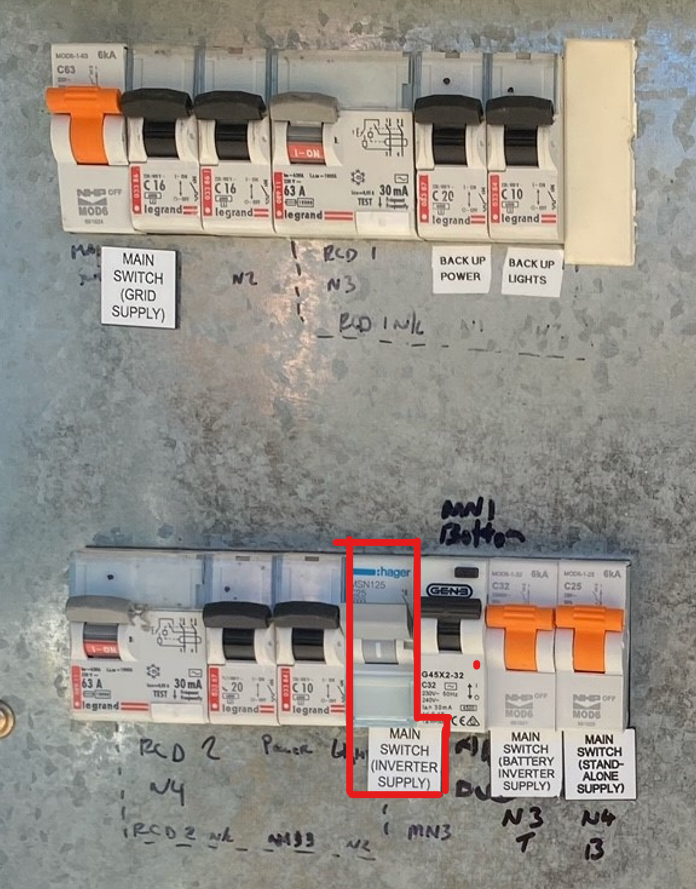
There can be slight discrepancies in the data collected by Plico and Synergy for the VPP. There are a few reasons for this:
- Synergy collects data on the half an hour, every half an hour.
- Plico collects data every minute, however not necessarily rounded to the nearest minute, i.e. it could be 17:31:02.
- The positioning of the meters also differs and this has a slight impact on readings.
Data collected for the VPP includes grid energy consumption and grid exports – or your household’s total VPP impact. The data is used for reporting and to calculate VPP credits.
For minimum demand activations, Synergy uses Western Power metering data. If you have any queries about minimum demand credits and how they are calculated, please contact Synergy at synergysolarrewards@synergy.net.au or go to: www.synergy.net.au/myaccount.
For peak demand activations, Plico uses its own cloud-based data collected from each inverter through the Amp X digital monitoring platform. You can contact us regarding any peak demand credits and calculations.

Still can’t find the answer to your question?
Speak to one of our switched on Plico people.
1300 175 426
